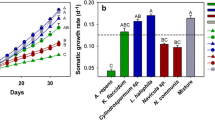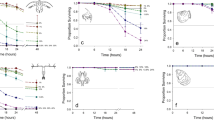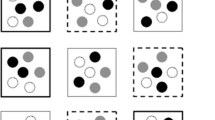Abstract
Gulf of Mexico blooms of the dinoflagellate Karenia brevis produce neurotoxic cyclic polyethers called brevetoxins. During and after a red tide bloom in southwestern Florida, K. brevis cells lyse and release brevetoxins, which then sink to the benthos and coat the surfaces of seagrasses and their epiphytes. We tested the possibility that these brevetoxin-laden foods alter the feeding behavior and fitness of a common benthic herbivore within Floridean seagrass beds, the amphipod Ampithoe longimana. We demonstrated that coating foods with K. brevis extracts that contain brevetoxins at post-bloom concentrations (1 μg g−1 drymass) does not alter the feeding rates of Florida nor North Carolina populations of A. longimana, although a slight deterrent effect was found at eight and ten-fold greater concentrations. During a series of feeding choice assays, A. longimana tended not to be deterred by foods coated with K. brevis extracts nor with the purified brevetoxins PbTx-2 and PbTx-3. Florida juveniles isolated with either extract-coated or control foods for 10 days did not differ in survivorship nor growth. A similar lack of feeding response to brevetoxin-laden foods also was exhibited by two other generalist herbivores of the southeastern United States, the amphipod A. valida and the urchin Arbacia punctulata. Given that benthic mesograzers constitute a significant portion of the diet for the juvenile stage of many nearshore fishes, we hypothesize that the ability of some mesograzers to feed on and retain brevetoxins in their bodies indicates that mesograzers may represent an important route of vertical transmission of brevetoxins through higher trophic levels within Gulf of Mexico estuaries.





Similar content being viewed by others
References
Alcock, F. 2007. An assessment of Florida red tide: Causes, consequences and management strategies, p. 40. Technical Report #1190. Sarasota, FL: Mote Marine Laboratory.
Baden, D. G. 1989. Brevetoxins: unique polyether dinoflagellate toxins. FASEB J. 3:1807–1817.
Baden, D. G., Bourdelais, A. J., Jacocks, H., and Michelliza, S. 2005. Natural and derivative brevetoxins: historical background, multiplicity, and effects. Environ. Health Perspect. 113:621–625.
Brand, L. E. and Compton, A. 2007. Long-term increase in Karenia brevis abundance along the Southwest Florida Coast. Harmful Algae 6:232–252.
Brawley, S. H. 1992. Mesoherbivores, pp. 235–263, in D. M. John, S. J. Hawkins and J. H. Price (eds.). Plant-animal interactions in the marine benthos. Clarendon, Oxford.
Breier, C. F. and Buskey, E. J. 2007. Effects of the red tide dinoflagellate, Karenia brevis, on grazing and fecundity in the copepod Acartia tonsa. J. Plankton Res. 29:115–126.
Bricelj, V. M., Connell, L., Konoki, K., Macquarrie, S. P., Scheuer, T., Catterall, W. A., and Trainer, V. L. 2005. Sodium channel mutation leading to saxitoxin resistance in clams increases risk of PSP. Nature 434:763–767.
Brooks, R. A. and Bell, S. S. 2001. Mobile corridors in marine landscapes: enhancement of faunal exchange at seagrass/sand ecotones. J. Exp. Mar. Biol. Ecol. 264:67–84.
Cohen, J. H., Tester, P. A., and Forward, R. B JR. 2007. Sublethal effects of the toxic dinoflagellate Karenia brevis on marine copepod behavior. J. Plank. Res. 29:301–315.
Colin, S. P. and Dam, H. G. 2002. Latitudinal differentiation in the effects of the toxic dinoflagellate Alexandrium spp. on the feeding and reproduction of populations of the copepod Arcatia hudsonica. Harmful Algae 1:113–125.
Cruz-Rivera, E., and Villareal, T. A. 2006. Macroalgal palatability and the flux of ciguatera toxins through marine food webs. Harmful Algae 5:497–525.
Darnell, R. M. 1961. Trophic spectrum of an estuarine community, based on studies of Lake Pontchartrain, Louisiana. Ecology 42:553–568.
Doucette, G., Maneiro, I., Riveiro, I., and Svensen, C. 2005. Phycotoxin pathways in aquatic food webs: transfer, accumulation and degradation, pp. 285–295, in E. Graneliand and J. T. Turner eds. Ecology of Harmful Algae,. Springer-Verlag, Berlin.
Fire, S. E., Flewelling, L. J., Naar, J., Twiner, M. J., Henry, M. S., Pierce, R. H., Gannon, D. P., Wang, Z., Davidson, L., and Wells, R. S. 2008. Prevalence of brevetoxins in prey fish of bottlenose dolphins in Sarasota Bay, Florida. Mar. Ecol. Prog. Ser. 368:283–294.
Flewelling, L. J. 2008. Vectors of brevetoxins to marine mammals. Ph.D. dissertation. University of South Florida, 143 pp.
Flewelling, L. J., Naar, J. P., Abbott, J. P., Baden, D. G., Barros, N. B., Bossart, G. D., Bottein, M. Y., Hammond, D. G., Haubold, E. M., Heil, C. A., Henry, M. S., Jacocks, H. M., Leighfield, T. A., Pierce, R. H., Pitchford, T. D., Rommel, S. A., Scott, P. S., Steidinger, K. A., Truby, E. W., Van Dolah, F. M., And Landsberg, J. H. 2005. Brevetoxicosis: red tides and marine mammal mortalities. Nature 435:755–756.
Haubois, A. G., Bricelj, V. M., and Naar, J. P. 2007. Transfer of brevetoxins to a telliid bivalve by suspension-and deposit-feeding and its implications for clay mitigation of Karenia brevis blooms. Mar. Biol. 151:2003–2012.
Hay, M. E. and Kubanek, J. 2002. Community and ecosystem level consequences of chemical cues in the plankton. J. Chem. Ecol. 28:2001–2016.
Hughes, A., Bando, K. J., Rodriguez, L., and Williams, S. 2004. Relative effects of grazers and nutrients on seagrasses: a meta-analysis approach. Mar. Ecol. Prog. Ser. 282:87–99.
Jernakoff, P., Brearsley, A., and Nielsen, J. 1996. Factors affecting grazer-epiphyte interactions in temperate seagrass meadows. Oceanogr. Mar. Biol. Ann. Rev. 34:109–362.
Keppler, C., Lewitus, A., Ringwood, A., Hoguet, J., and Staton, T. 2006. Sublethal cellular effects of short-term raphidophyte and brevetoxin exposures on the eastern oyster Crassostrea virginica. Mar. Biol. Prog. Ser. 312:141–147.
Kubanek, J., Snell, T. W., and Pirkle, C. 2007. Chemical defense of the red tide dinoflagellate Karenia brevis against rotifer grazing. Limnol. Oceanogr. 52:1026–1035.
Landsberg, J. 2002. The effects of harmful algal blooms on aquatic organisms. Rev. Fish. Sci. 10:113–390.
Landsberg, J., Van Dolah, F., and Doucette, G. 2005. Marine and estuarine harmful algal blooms: impacts on human and animal health, pp. 165–215 in S. S. Belkin and R. Colwell, eds. Oceans and Health: Pathogens in the Marine Environment, Springer, New York.
Leverone, J. R., Blake, N. J., Pierce, R. H., and Shumway, S. E. 2006. Effects of the dinoflagellate Karenia brevis on larval development in three species of bivalve mollusc from Florida. Toxicon 48:75–84.
Leverone, J. R., Shumway, S. E., and Blake, N. J. 2007. Comparative effects of the toxic dinoflagellate Karenia brevis on clearance rates in juveniles of four bivalve mollusks from Florida, USA. Toxicon 49:634–645.
Luczkovich, J., Ward, G., Johnson, J., Christian, R., Baird, D., Neckles, H., and Rizzo, W. 2002. Determining the trophic guilds of fishes and macroinvertebrates in a seagrass food web. Est. Coasts. 25:1143–1163.
Marancik, K. E. and Hare, J. A. 2007. Large scale patterns in fish trophodynamics of estuarine and shelf habitats of the southeast United States. Bull. Mar. Sci. 80:67–91.
Maucher, J. M., Briggs, L., Podmore, C., and Ramsdell, J. S. 2007. Optimization of blood collection card method/enzyme-linked immunoassay for monitoring exposure of bottlenose dolphin to brevetoxin-producing red tides. Environ. Sci. Tech. 41:563–567.
Motta, P. J., Clifton, K. B., Hernandez, P., and Eggold, B. T. 1993. Feeding relationships among nine species of seagrass fishes of Tampa Bay, Florida. Bull. Mar. Sci. 56:185–200.
Naar, J. P., Flewelling, L. J., Lenzi, A., Abbott, J. P., Granholm, A., Jacocks, H. M., Gannon, D., Henry, M., Pierce, R. H., Baden, D. G., Wolny, J., and Landsberg, J.H.. 2007. Brevetoxins, like ciguatoxins, are potent ichthyotoxic neurotoxins that accumulate in fish. Toxicon 50:707–723.
Nelson, W. G. 1980. A comparative study of amphipods in seagrasses from Florida to Nova Scotia. Bull. Mar. Sci. 30:80–89.
Poli, M., Musser, S., Dickey, R., Eilers, P., and Hall, S. 2000. Neurotoxic shellfish poisoning and brevetoxin metabolites: a case study from Florida. Toxicon 38:981–993.
Prince, E. K., Lettieri, L., Mccurdy, K. J. and Kubanek, J. 2006. Fitness consequences for copepods feeding on a red tide dinoflagellate: deciphering the effects of nutritional value, toxicity and feeding behavior. Oecologia 147:479–488.
Santos, S. and Simon, J. 1980. Response of soft-bottom benthos to annual catastrophic disturbance in a south Florida estuary. Mar. Ecol. Prog. Ser. 3:347–355.
Simon, J. and Dauer, D. 1972. A quantitative evaluation of red-tide induced mass mortalities of benthic invertebrates in Tampa Bay. Florida. Environ. Lett. 3:229–234.
Sotka, E. E. and Whalen, K. 2008. Herbivore offense in the sea: the detoxification and transport of secondary metabolites, pp. 203–228 in C. Amsler (ed.). Algal chemical ecology, Springer-Verlag. Berlin.
Sotka, E. E. and Hay, M. E. 2002. Geographic variation among herbivore populations in tolerance for a chemically-rich seaweed. Ecology 83:2721–2735.
Sotka, E. E., Wares, J. P., and Hay, M. E. 2003. Geographic and genetic variation in feeding preference for chemically defended seaweeds. Evolution 57:2262–2276.
Steidinger, K. A., Vargo, G. A., Tester, P. A., and Tomas, C. R. 1998. Bloom dynamics and physiology of Gymnodinium breve with emphasis on the Gulf of Mexico, pp. 133–153 in D. M. Anderson, A. D. Cembella and G. M. Hallegraeff (eds.). Physiological ecology of harmful algal blooms, Springer-Verlag. Berlin.
Stoner, A. 1979. Species-specific predation on amphipod crustacea by the pinfish Lagodon rhomboides: mediation by macrophyte standing crop. Mar. Biol. 55:201–207.
Summerson, H., and Peterson, C. 1990. Recruitment failure of the bay scallop, Argopecten irradians concentricus, during the first red tide, Ptychodiscus brevis, outbreak recorded in North Carolina. Est. Coasts. 13:322–331.
Tester, P. A., Shea, D., Kibler, S. R., Varnam, S. M., Black, M. D., and Litaker, R. W. 2008. Relationships among water column toxins, cell abundance and chlorophyll concentrations during Karenia brevis blooms. Cont. Shelf Res. 28:59–72.
Tester, P. A. and Steidinger, K. A. 1997. Gymnodinium breve red tide blooms: initiation, transport, and consequences of surface circulation. Limnol. Oceanogr. 42:1039–1051.
Tester, P. A., Turner, J. T., and Shea, D. 2000. Vectorial transport of toxins from the dinoflagellate Gymnodinium breve through copepods to fish. J. Plank. Res. 22:47–61.
Turner, J. T. and Tester, P. A. 1997. Toxic marine phytoplankton, zooplankton grazers, and pelagic food webs. Limnol. Oceanogr. 42:1203–1214.
Twiner, M. J., Dechraoui, M. Y. B., Wang, Z., Mikulski, C. M., Henry, M. S., Pierce, R. H., and Doucette, G. J. 2007. Extraction and analysis of lipophilic brevetoxins from the red tide dinoflagellate Karenia brevis. Anal. Biochem. 369:128–135.
Van Dolah, F., Roelke, D., and Greene, R. M. 2001. Health and ecological impacts of harmful algal blooms: risk assessment needs. Hum. Ecol. Risk Assess. 7:1329–1345.
Virnstein, R. W. 1987. Seagrass-associated invertebrate communities of the southeastern USA: a review, pp. 89–116 in M. J. Durako, R. C. Phillips and R. R. Lewis (eds.). Proceedings of the Symposium on subtropical-tropical seagrasses of the southeastern United States. Florida Marine Research Publication.
Wang, Z. H., Plakas, S. M., El Said, K. R., Jester, E. L. E., Granade, H. R., and Dickey, R. W. 2004. LC/MS analysis of brevetoxin metabolites in the Eastern oyster (Crassostrea virginica). Toxicon 43:455–465.
Acknowledgements
We thank Marie DeLorenzo, Spencer Fire, Hannah Giddens, Tod Leighfield, and Zhihong Wang for brevetoxin analyses, fruitful discussion or both. N.O. was supported by an NSF Research Experience for Undergraduates fellowship (DBI-0552828) and the Department of Defense ASSURE Program. E.E.S. and A.M. were supported by a grant from NSF (OCE-0550245). This is Grice Marine Laboratory publication number 342 and NOAA CCEHBR CL-1460. The National Ocean Service does not approve, recommend or endorse any proprietary product or material mentioned in this publication.
Author information
Authors and Affiliations
Corresponding author
Rights and permissions
About this article
Cite this article
Sotka, E.E., McCarty, A., Monroe, E.A. et al. Benthic Herbivores are not Deterred by Brevetoxins Produced by the Red Tide Dinoflagellate Karenia Brevis . J Chem Ecol 35, 851–859 (2009). https://doi.org/10.1007/s10886-009-9658-9
Received:
Revised:
Accepted:
Published:
Issue Date:
DOI: https://doi.org/10.1007/s10886-009-9658-9




